

The warmer weather continues and more blossom appears each day; Plums and Pears are in bloom and Apples on the way!
This week The English Apple Man visited Highland Court in East Kent on Wednesday morning to see a new sprayer system demonstrated and spoke to a local Horticultural Society in the evening. On Thursday a visit to Chris & Sheenagh Levett at their farm in Hawkhurst, Kent where Cherries were coming into blossom.
LIPCO trailer mounted two row 're-circulating' orchard sprayer.
This machine has been developed for use in apple and pear orchards in Germany from similar sprayers which have been in operation in Vineyards in Germany, Austria and beyond for a number of years.
The hydraulically operated collection panels catch any spray which does not land on the leaves and branches of the tree and drains it into a recycling unit which filters the excess spray before returning it to the sprayer tank. The benefits are significant saving on spray chemicals and avoidance of spray residue drifting onto the ground and adjacent areas of the local environment.
The manufacturer claims savings of 40% can be made across the season. Up to 70% savings can be made in the early part of the season when there is minimal leaf and even in the later stages when the tree has full leaf cover, it is still possible to save 30% of the spray chemicals. Across the season 40% savings can be made.
During the demonstration The English Apple Man discussed the potential savings with one grower who has 120 hectares of apples and pears (about 288 acres) told me his spray bill comes to £120,000 per year; this size of farm would require two sprayers but if savings of 40% can be made with the LIPCO sprayer which costs £40,000 he estimates that with the chemical saving and time saved by spraying two rows at a time, the capital outlay should be recouped in 2-3 seasons.
Below left: LIPCO two row sprayer - Below right: controls system in the tractor cab
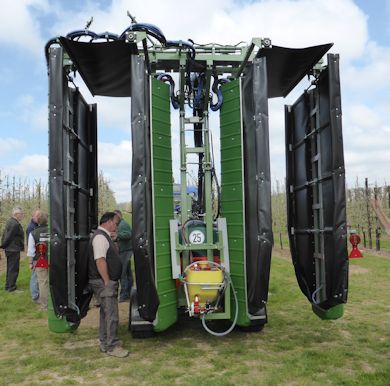
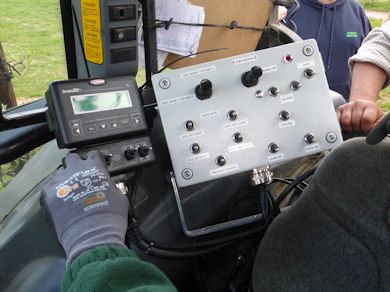
The importance of hydraulic controls cannot be 'understated' as the system allows easy operation by the spray operator from his tractor cab as the fine adjustment of the spray panels are made. The ability to adjust the spray volume by programming automatic settings and a manual override which can be tweaked and returned to automatic just by moving a switch on the control panel adds to the sophistication of this truly well engineered spraying system.
Below left: The hydraulic reservoir holds 100 litres of oil - Below right: Excess spray is collected and recirculated
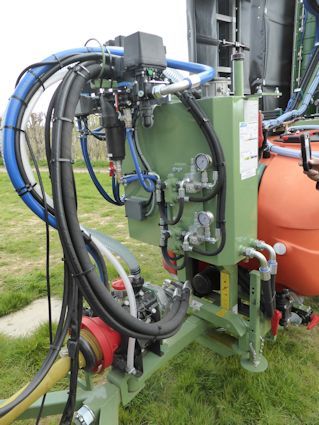
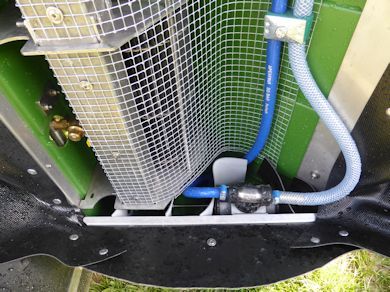
Just a few months ago I agreed to speak to members of the Rotherfield Horticultural Society in East Sussex; on Wednesday evening infront of 30 + RHS (hhhmmm - RHS!) members I covered the story of the domestic apple back to the Tian Shan (mountains) in Western China right up to the present day. A most enjoyable evening for me with a very appreciative audience of keen horticulturists.
On Thursday evening I called in on my old friend Chris Levett who farms at Hawkhurst in West Kent with his wife Sheenagh and son Christian. On what was a gloriously sunny evening with 'not a cloud' in the sky, we strolled around the very impressive Cherry orchards with Merchant and Van in bloom and Kordia in the white bud to early blossom stage.
Cherry growing has changed dramatically from 100 years ago when '70 stave ladders' were needed to reach the tops of the giant trees growing in orchards along the A2 between Faversham and Sittingbourne in East Kent, and birds were kept at bay with a shotgun. Today modern cherry production is a much more precise affair; modern Gisella 'dwarfing root-stocks' allow a much more compact tree shape and a more precocious cropper. Combining the Gisella rootstock with new varieties has created a vastly different cherry industry which continues to expand.
Panoramic view of Chris Levett's cherry covers

While all of the Cherries are protected from bird damage by netting covering the orchards, the largest area is protected by rain covers. This is now a standard procedure on UK cherry farms as this 'high value' crop can be ruined by rain 'at or near' the ripening stage. Additionally the covers allow the fruit to stay on the tree for longer adding 'size, weight and flavour' to the fruit.
Below left: Merchant cherries in bloom - Below right: Vanda cherries in bloom
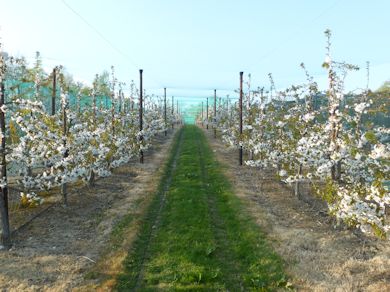
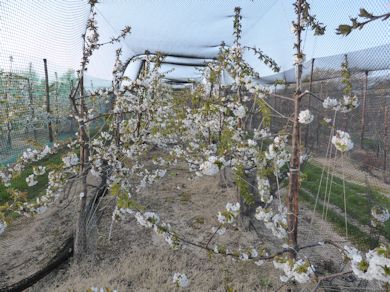
Cherry covering systems
There are many different covering systems available for cherries; early systems tended to be modified strawberry tunnels, but these have been replaced by much more sophisticated materials with the ability to breathe and reduce condensation. Some of the covering systems cost circa £35,000 per hectare.
Chris Levett has purchased a system which costs £1 per square metre or £10,000 per hectare. The initial erection of the covers onto the mountings was £8,000 per ha - total £18,000 per ha.
When I visited on Thursday, all the covers were in place; e.g. they had been unrolled from their 'winter position' where the covers are rolled up into a compact 'tube' along the apex of the support structure. In conversation with Chris he told me he is considering leaving the covers in position throughout the winter instead of rolling them up at the end of the season. His 'rationale' - it costs about £1,800 to roll out and roll up the covers each year. Also one of the 'bugbears' of Cherry growing is bacterial canker which is exacerbated by wet conditions; by maintaining a dry environment the canker would be much easier to control. In answer to my question about adequate light for fruit bud formation, Chris said the covers will reduce light by 15% and he thinks this would prove acceptable.
The 64,000 dollar question is; 'will the covers survive any gales? the covers are designed to survive wind speeds up to 70mph. Chris thinks it may require a rope or net system over the top to add stability.
Below left: Tunnel covers in place ready for the season ahead; Below right: Kordia cherries in bloom
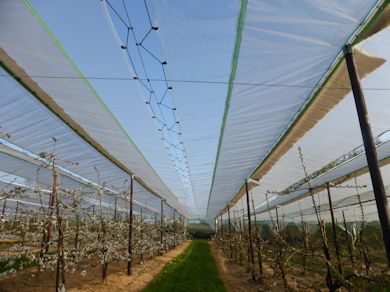
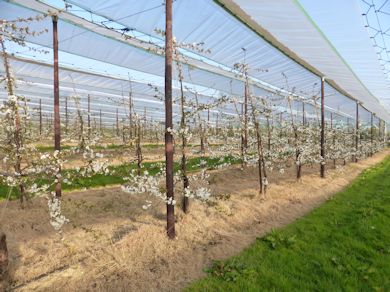
Below left: By twisting the leader around the stake as it grows upwards, vigour is controlled - Below right: Tying down branches is an important part of initiating fruit bud formation
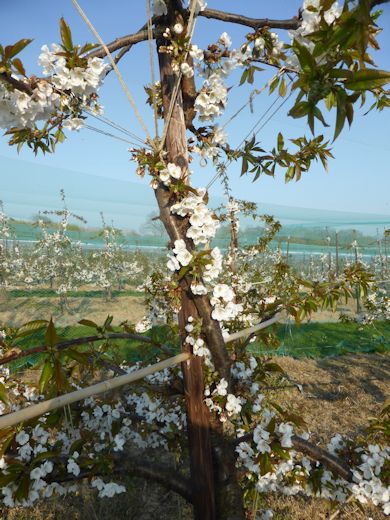
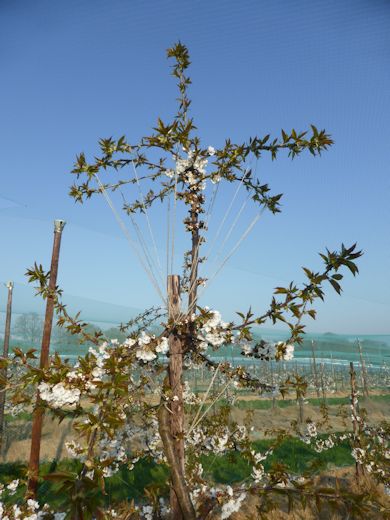
Pollination
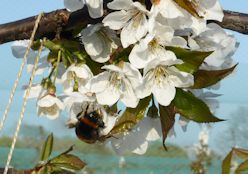 As we toured the cherry orchards, bees were happily working among the blossoms; the speed with which they move from one bloom to another is quite amazing, and it takes a patient soul with a camera to catch one in a 'working mode' however this bee managed to 'pose' for a few seconds. While we were making our way back to the farmyard, Chris pointed out 'solitary bee' homes beneath our feet; along a gentle slope which sits in a warm spot facing the direction of the Sun we saw an amazing number of holes in the soil; each one the home of a solitary bee.
As we toured the cherry orchards, bees were happily working among the blossoms; the speed with which they move from one bloom to another is quite amazing, and it takes a patient soul with a camera to catch one in a 'working mode' however this bee managed to 'pose' for a few seconds. While we were making our way back to the farmyard, Chris pointed out 'solitary bee' homes beneath our feet; along a gentle slope which sits in a warm spot facing the direction of the Sun we saw an amazing number of holes in the soil; each one the home of a solitary bee.
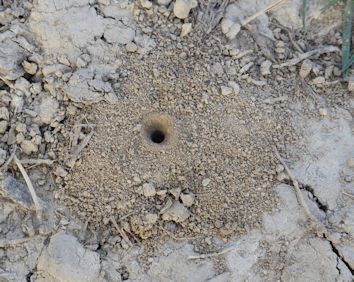
That is all for this week........next week The English Apple Man will be in apple orchards in East Kent as they come into blossom
Take care
The English Apple Man